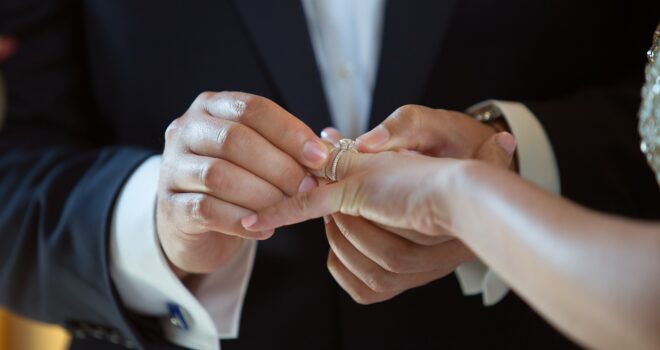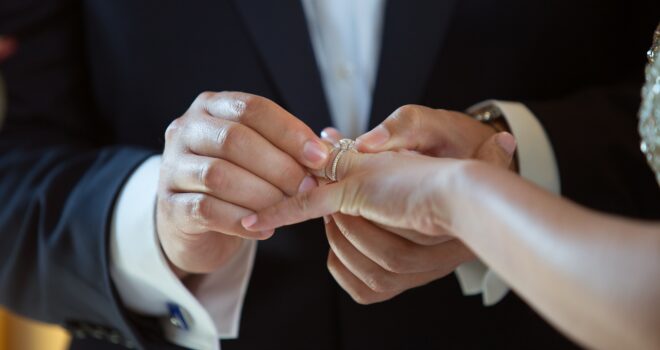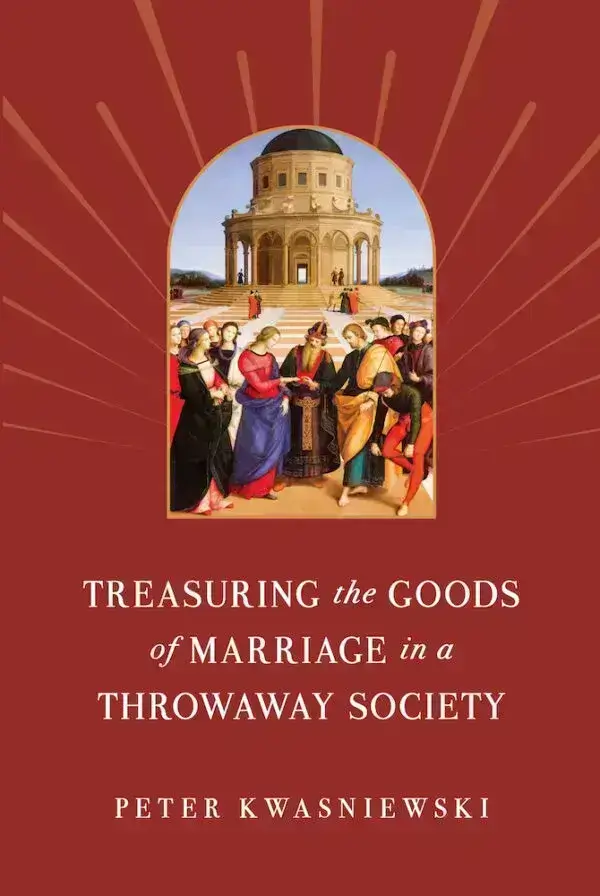There was a marriage the other day in a rural corner of America. It occurred at a Catholic chapel situated on a knoll overlooking farm fields, a woodlot, and a cemetery. On that warm July day, the bride and groom, both children of large faithful families, stood before the congregation of men, women, and children, and plighted their troth. The bride, a local girl beautiful in her hand-sewn white dress and veil, and the groom, an aeronautical engineer from Australia tall and manly in blue, heard the priest (the bride’s cousin) speak of Catholic marriage: duty, sacrifice, love, sanctification, and raising children for eternal life with God. The numerous babies and toddlers there cried their affirmation.
Then the priest went before the altar and the schola began the Introit: “Deus Israel con ungat vos” (May the God of Israel join you together). Except for a few additional prayers, it was the Mass, but a nuptial Mass. There were no ad-hoc vows or secular love songs. This was a Catholic wedding, and almost everyone appeared to be a faithful Catholic, familiar with the Mass (many following in well-worn hand missals) and dressed appropriately for the occasion. There was nothing amiss. Everything was done according to its intended purpose.
This was no fairy tale. It was real and my wife and I were privileged and blessed to witness our first traditional Catholic wedding. I was especially glad to be there, since the wedding manifested so many elements of the book I had finished days earlier, Peter Kwasniewski’s Treasuring the Goods of Marriage in a Throwaway Society, an indispensable guide to one of our sacraments. Indeed, chapter eight of his book, “How to Elevate the Dignity of Weddings,” was beautifully illustrated at the wedding we attended. It was dignity incarnate.
But the prolific Kwasniewski has not put together a mere etiquette guide; rather, this is a wide-ranging examination of the essence and nature of marriage. Even more, I’d call this a primer in Thomistic anthropology, since the author—more than in his books on the liturgy, which lean heavily on theology—uses the tool of Aquinas’s philosophy to make connections between actions on earth in time and in the timeless heavenly realms. Lest the potential reader despair, I hasten to say this is an accessible book, and there is only one chapter eEleven) the author advises may be skipped due to its “rather dense philosophical argument.” The book is divided into four sections: “Marriage and Family,” “Living Chastely,” “Virginity and Celibacy,” and “Contraception and Abortion.” Like other Kwasniewski books, this one is a compilation of articles from various sites. The result is a book of chapters of varying length—though none are overly long—which, while not seamless, is coherent. A reader could read chapters according to interest, though the book works best in sequence.
Treasuring the Goods of Marriage encompasses many useful topics. Most importantly, Kwasniewski lays out the fundamental realities laid out by God and contrary to the values of our deteriorating society. There is the witness of scripture and the very words of Our Lord Jesus on marriage, as well as the clear teachings of the Church beginning with St. Paul. Rather than spending much time on all the worldly and ungodly counterfeits of marriage and human nature, Kwasniewski focuses on what has always been taught by the Church: the characteristics of male and female, the indissolubility of marriage, the purposes of marriage (procreation and mutual help), the non-negotiable hard sayings about sacrifice, the role of our bodies, and, most of all, the proper ordering of our lives. In that sense Kwasniewski has done a great service in all his writing by repeatedly bringing home the concept of things properly ordered. For example: human sexuality is a tremendous gift. However, it is intended to be properly ordered. In other words, it is to be an act of self-giving between husband and wife and always open to the transmission of life. Any other use is the equivalent of doctors writing “off-label” prescriptions for drugs to be used in unintended fashion.
The author tackles some Catholic hot topics. He takes a balanced look at John Paul II’s Theology of the Body (TOB), especially in chapter ten, “Is the Human Body Part of the ‘Image of God’?” His conclusions respect both John Paul’s efforts while setting TOB into a broader context of teaching on God and the body. In chapter thirty, “Why the Church’s peace and Unity Depend on Humanae Vitae,” he tackles Natural Family Planning (NFP), derided by some as “Catholic birth control.” Using the language of philosophy, Kwasniewski contends that the crux of the issue involves intention and recognition of God’s control over our lives.
Perhaps unexpectedly, Treasuring the Goods of Marriage is not an argument that marriage is the greatest good. Basing his arguments on scripture (especially St. Paul) and tradition, Kwasniewski firmly defends the consecrated life as superior to marriage. Thus he looks at virginity and celibacy as part of his analysis of marriage. The good desire for marriage, children, and the help and comfort of a spouse must never become ends in themselves. They must be considered and practiced as the way to eternal life with God. Even marriage can become an idol.
Neither should childless couples be considered as somehow deficient. Childlessness is a cross, particularly in communities with large families. “Obviously, those who deeply desire to have children and cannot must bear this cross with the help of God’s grace, for their infertility is certainly neither chosen nor blameworthy. Childlessness is in truth the deepest sorrow and burden for those who have a worthy conception of marriage and human life” (200). This is a topic I hope Kwasniewski might return to at greater length some day.
I began this review with an extended anecdote of a wedding. I close it with a brief reflection on another book I read at the same time as Treasuring the Goods of Marriage, which perfectly elucidates Kwasniewski’s themes. The book is That Hideous Strength by C.S. Lewis. For all its sci-fi and fantasy trappings, the core element in the book is a disordered marriage. At the beginning, newlywed Jane Studdock is rebelling at what she sees as the strictures of marriage to her academic husband, Mark. The couple are having difficulties with self-sacrifice, their sex life, and their respective roles in decision-making. They are also avoiding pregnancy. By novel’s end, and through both earthly and heavenly help, they have reordered their priorities and seem ready for a nuptial reset.
Encountering authentic marriage can both shock and inspire. The prevalence of cohabitation, unmarried parents, divorce, and so-called “same-sex marriage” can incline the tradition-minded to despair. Kwasniewski offers tough love as an antidote. Marriage in this fallen world can be and often is hard, but the benefits and outcomes are rewarded if not here then in eternity. Holy Tradition is full of nuptial imagery, meaning God wants us to take notice. A recent daily reading from Dom Gueranger’s The Liturgical Year provides a suitable example. Gueranger’s exegesis on the readings and themes of the Sixth Sunday after Pentecost center on St. Paul’s mission to the Gentiles. “He will not rest until he has led this once poor, despised Gentile world to the nuptial union with Christ” (Volume Eleven, 155). God wants us all in His family. “For all its humble ‘ordinariness,’ the family is the first school in which children learn about transcendent things—about God, the saints, eternal truths, virtues, commitment, self-sacrifice, self-discipline. Christian marriage witnesses to the children that there is something permanent, abiding, rock-solid, resting on Christ and sustained by His Spirit” (263).
Treasuring the Goods of Marriage in a Throwaway Society, with its thoughtful and challenging content, its useful list of references and resources, and its accessible but not dumbed-down style, is a wonderful addition to the library of must-have Catholic books on marriage. (Like, for instance, Fulton Sheen’s Three to Get Married.) It would be valuable for marriage prep, newlyweds, or those long-married, as well as priests and seminarians to help in their formation as pastors.
Additional Resources: Another review of Kwasniewski’s book at 1Peter5 here. A quick compendium of marriage material here.
Treasuring the Goods of Marriage in a Throwaway Society is available from Sophia Institute Press.














